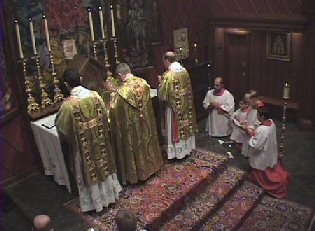Anglican-Catholic Music
by Gary D. Penkala
 Pope Benedict XVI, in a dramatic and benevolent gesture, has made it possible for Anglicans to enter the Catholic Church, retaining some of their liturgical heritage.
Pope Benedict XVI, in a dramatic and benevolent gesture, has made it possible for Anglicans to enter the Catholic Church, retaining some of their liturgical heritage.
The Catholic Church is responding to the many requests that have been submitted to the Holy See from groups of Anglican clergy and faithful in different parts of the world who wish to enter into full visible communion.
The Holy Father has introduced a canonical structure that provides for such corporate reunion by establishing Personal Ordinariates, which will allow former Anglicans to enter full communion with the Catholic Church while preserving elements of the distinctive Anglican spiritual and liturgical patrimony.
Under the terms of the Apostolic Constitution, pastoral oversight and guidance will be provided for groups of former Anglicans through a Personal Ordinariate, whose Ordinary will usually be appointed from among former Anglican clergy.
The Apostolic Constitution provides a reasonable and even necessary response to a world-wide phenomenon, by offering a single canonical model for the universal Church which is adaptable to various local situations and equitable to former Anglicans in its universal application.
There are many ways that an influx of "liturgically savvy" Anglo-Catholics can have a beneficial effect on music within the Catholic Church.
Think of English-texted chanting of propers [to Anglican chant]; think of the beautiful Mass settings, in both Latin and in English, from the English tradition [Byrd, Tallis, Merbecke].
Here are some tools and music that are currently available, which can add solemnity and beauty to Roman Catholic worship — from an "Anglican" perspective:
- The Anglican Use Gradual, chanted English Mass propers for the liturgical year, in Gregorian neums.
- Saint Dunstan's Plainsong Psalter, the Psalms and Canticles set to ancient Gregorian and British tones.
- Passion according to Saint John, set to ancient Passion chant formula; turbo music by William Byrd.
- Lamb of God, a congregational setting by Johannes Somary followed by a choral setting by Adrian Batten.
- Thaxted Acclamations, the Sanctus, Memorial Acclamation, Amen and Agnus Dei based on the Holst-inspired British hymn tune Thaxted.
- Canticle of the Lamb, a Canadian setting of Revelation 19:1-7, reminiscent of William Byrd.
- The Canticles of Evening, the Magnificat and Nun dimittis set to music of Farrant.
- Let My Prayer Come Up, Psalm 141 by British composer Alan Smith.
- Behold My Servant, written for the ordination of an Anglican bishop in California.
- Complete Thy Work, O Lord, a Victorian-style motet by Calvert Shenk.
- Eternal Light, Shine in Our Hearts, by Leeds composer Tim Knight.
- Give Judgement for Me, O Lord, in English cathedral style by Australian Colin Brumby.
- In Praise of the Virgin, a macaronic carol mixing English and Latin.
- Prayer of Saint Richard of Chichester.
- Soul of Christ, Sanctify Me, the Ignatian prayer set by a composer from West Sussex, England.
- The Promise of Advent, adapted from the Oxford Book of Carols.
- Veni Creator Spiritus, 2-part setting of the chant by Portsmouth composer Derek Fry.
- Hambleton Suite, for organ — manuals only.
- Maestoso: Five Processionals, organ music in 20th century British style.
- Music for a Festive Occasion, contemporary British organ music.
- The Solemn Organ, contemporary British organ music.
- Be unto Me, O Lord, a Tower of Strength, an anthem by William Byrd.
- Salvator mundi, a 5-part motet by Thomas Tallis.
- This Is the Record of John, by Orlando Gibbons.
- Magnus Sanctus Paulus, a CD of Scripture and music.
|


 Pope Benedict XVI, in a dramatic and benevolent gesture, has made it possible for Anglicans to enter the Catholic Church, retaining some of their liturgical heritage.
Pope Benedict XVI, in a dramatic and benevolent gesture, has made it possible for Anglicans to enter the Catholic Church, retaining some of their liturgical heritage.